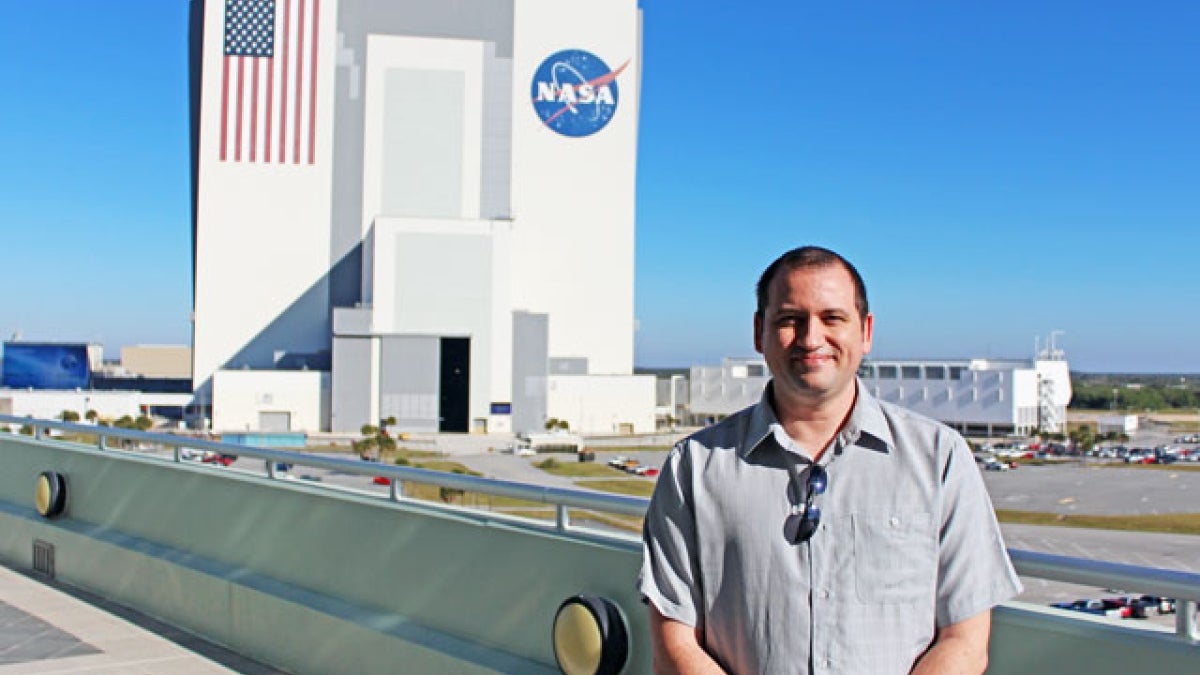Air Force veteran turned engineer lands NASA internship

Kristopher Maham, an electrical engineering undergraduate, at the Kennedy Space Center in Cape Canaveral, Florida, where he is an intern in a NASA Pathways Program. Photo by Bonni McClure/NASA
Kristopher Maham’s life as a college student is anything but traditional.
He is a U.S. Air Force veteran, husband, father of two girls and a first-time undergraduate student at the age of 37 in Arizona State University’s Ira A. Fulton Schools of Engineering. Now he is further distinguishing himself through a prestigious internship with the National Aeronautics and Space Administration (NASA).
Maham, an electrical engineering student, will spend one semester each year interning on-site at NASA’s Kennedy Space Center in Cape Canaveral, Florida, for the duration of his undergraduate studies.
His work focuses on power production and distribution used by the various facilities at the center. He is part of the Construction of Facilities Department, which ensures that the center’s facilities are capable of supporting NASA's missions, including that they are kept safe, secure, environmentally sound and operated efficiently and effectively.
“Our current projects focus on major upgrades to the safety and reliability of the center’s power substations, as well as expanding an on-site solar power plant, more than doubling its current capacity,” Maham said.
These projects will secure the center’s energy needs as NASA continues to develop and deploy the next generation of space travel and exploration systems. Maham is working closely with a mentor to ensure these projects meet the required specifications as they transition from design to construction.
He began the on-site portion of the internship in January, and will work at the center for the remainder of the spring semester. In May (or August if he chooses to extend his duties) he will return to Arizona and continue classes on the ASU Tempe campus in the fall semester.
From avionics technician to electrical engineering student
While efforts promoting space travel might be a new realm for Maham, air travel is not.
He served in the Air Force as an avionics technician on fighter aircraft for nearly 18 years until taking advantage of an early-retirement program in 2014.
Originally from Minot, North Dakota, Maham was stationed at Luke Air Force Base in Glendale, Arizona, for five years and decided to return to Arizona after his retirement because it was a good location for his family.
Kristopher Maham with his family at his retirement ceremony in May 2014. He served in the U.S. Air Force for nearly 18 years. From left to right: Family friend Tiffany Sapp, wife Melanie Maham, daughter Kristina, Kristopher Maham and daughter Lindsey. Photo courtesy Tyndall AFB Public Affairs
“I enrolled at ASU because of the reputation the Pat Tillman Veterans Center has for transitioning vets back to civilian and student life,” Maham said. He also knew the Fulton Schools’ programs are highly rated.
Initially interested in aerospace engineering, Maham decided to pursue electrical engineering because the career choices are more in line with his interests in electronics and renewable-energy systems.
“Electrical engineering seems like the best way to leverage my avionics experience from the Air Force,” he said. He is also pursuing a minor in engineering management.
Maham is hopeful that his internship at NASA will convert to a permanent position.
“I would also like to pursue opportunities that allow me to stay in the Phoenix area, possibly with other aerospace companies or in the solar-power industry,” he said.
He also intends to pursue graduate studies at ASU.
Maham said transitioning from military service to academics has not been easy.
“I could not be doing it without the support of my family and the assistance of the Tillman Center,” he said.
The biggest challenge is relearning how to study and balance school and other obligations. Having school-age children adds to the balancing act. But Maham said it has been a bonding opportunity with his daughters, as he and the girls usually do their homework at the same time.
“Unfortunately, they can’t help me with my homework as much as I help them with theirs,” he said.
Maham’s oldest daughter will graduate from high school at about the same time that he finishes his undergraduate studies.
"ASU is on her list” of colleges she is interested in attending, he said.
He encourages fellow veterans to take advantage of benefits from the GI Bill — which, in addition to providing scholarships and grants, has enabled Maham to enroll as a full-time student and to pay his tuition and bills without additional employment.
Maham learned about the NASA internship from a posting on the Facebook page of the Tempe chapter of the Student Veterans of America.
He feels his military experience helped him land the job.
“I am still just thrilled to have been accepted," he said. "I’m still relatively early in my engineering education, but my military skills can benefit NASA now.”
Maham was accepted into the Intern Employment Program that is part of NASA's Pathways Programs, which were established through an executive order by President Barack Obama in 2012. The programs serve to bolster a mission-focused workforce for the Kennedy Space Center, which is NASA's Center of Excellence for both launch and payload processing systems.
More Science and technology

ASU postdoctoral researcher leads initiative to support graduate student mental health
Olivia Davis had firsthand experience with anxiety and OCD before she entered grad school. Then, during the pandemic and as a…

ASU graduate student researching interplay between family dynamics, ADHD
The symptoms of attention deficit hyperactivity disorder (ADHD) — which include daydreaming, making careless mistakes or taking…

Will this antibiotic work? ASU scientists develop rapid bacterial tests
Bacteria multiply at an astonishing rate, sometimes doubling in number in under four minutes. Imagine a doctor faced with a…
